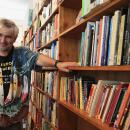David Kipen’s Great American Novel: The works of Thomas Pynchon
Let’s make this a whole lot easier. After Twain and Fitzgerald, there’s Thomas Pynchon and there’s everybody else. When we ask about the Great American Novel, what we’re really asking is, which of Pynchon’s novels is the most American?
For the uninitiated, it may bear mentioning here that Thomas Pynchon is an American writer, born a little over 79 years ago in Glen Cove, Long Island. Between the 1960s and the 1980s, he spent some time in California, where three of his eight novels are set. The others range all over the globe and throughout history, often in the same book.
After Twain and Fitzgerald, there’s Thomas Pynchon and there’s everybody else.
— David Kipen
To varying degrees, and woefully oversimplified, most of the novels pit a plucky heroine or poor, priapic, paranoid schnook against some vast, bureaucratic, merciless conspiracy.
The author’s most obvious candidate for the Great American Novel would seem to be “Mason & Dixon,” a playfully archaic picaresque about the two 18th century surveyors who drew the “geometrick Scar” along which, during the Civil War, America almost bled out. But the G.A.N. could just as easily be one of Pynchon’s other works, each of which rings a fresh variation on the same two questions: What happened to the country we wanted? And can its original promise ever be redeemed?
Our Critics at Large pick their Great American Novels
You could make a somewhat forced case that each of Pynchon’s books reconsiders what it means to be American, or Californian, at roughly decennial intervals.
“Gravity’s Rainbow” (which may itself be the Great European Novel) zeroes in on the mid-1940s. Half of “V.” and the long short story “The Secret Integration” (where Pynchon virgins should begin) on the late 1950s; “The Crying of Lot 49,” on the mid-’60s; “Inherent Vice,” the early ’70s; “Vineland,” the mid-’80s; and “Bleeding Edge,” the late ’90s. Essentially a historical novelist, Pynchon didn’t write the books in that order, but, in retrospect, a faint, probably unwitting design begins to appear.
The seven books already mentioned leave out only “Against the Day,” a transatlantic 2006 novel set at the turn of the 20th century, but with a post-9/11 shadow-story nested inside. This is the longest and least examined of all Pynchon’s novels, a few shiny nuggets already picked over while, all along, an undiscovered mother lode waits below.
Over the years, Pynchon himself has suggested everything from Kerouac’s “On the Road” to Oakley Hall’s “Warlock” as, if not the, at least among the great American novels. But can any one book ever be the G.A.N.? Or is it a mythical creature, a gryphon, more there to be tracked than ever finally treed?
And there it is, the ultimate critical cop-out. But to say that no one book is the G.A.N. is not the same as saying that the G.A.N. doesn’t exist. It does exist. It’s just eight books long, each of them named above.
But can any one book ever be the Great American Novel? Or is it a mythical creature, a gryphon, more there to be tracked than ever finally treed?
— David Kipen
Read straight through, all eight Pynchon novels fuse into one epic Pynchoverse, a crowded, panoramic canvas of the republic, from its earliest colonial stirrings clear down to the mounting, vertiginous terror of right now.
This career-spanning mega-novel begins to look uncannily like America itself — galvanized by genius, tarred with original sin, by turns revolutionary, frivolous and dark as a raven in a coal mine, routinely written off, almost as often reborn.
It may be that each era gets the Great American Novel it needs: “Huck Finn” for a nation still reeling from civil war and reckoning with race, “Gatsby” for that same country half a century on, rich and frisky after yet another war, veering blindly toward a looming Crash.
If these are the novels we got when we needed them, then Thomas Pynchon’s entire mighty post-War shelf — well into its sixth decade and still, we pray, growing — is the novel for us now.
Kipen is one of our Critics at Large
More to Read
Sign up for our Book Club newsletter
Get the latest news, events and more from the Los Angeles Times Book Club, and help us get L.A. reading and talking.
You may occasionally receive promotional content from the Los Angeles Times.








